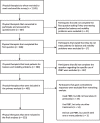A survey of Israeli physical therapists regarding reactive balance training
- PMID: 37833653
- PMCID: PMC10571354
- DOI: 10.1186/s12877-023-04356-5
A survey of Israeli physical therapists regarding reactive balance training
Abstract
Background: 'Reactive balance training' (RBT) was developed to improve balance reactions to unexpected losses of balance. Although this training method is effective, its practical usage in the field of physical-therapy in Israel and world-wide is still unclear.
Aims: This study aimed to evaluate the extent of RBT use in physical-therapy clinics in Israel, to identify the significant barriers to/facilitators for implementing RBT in clinical practice among physical therapists, and to determine which aspects of RBT most interest physical therapists in Israel.
Methods: Physical therapists in Israel completed a survey using a questionnaire regarding their knowledge and use of RBT in their clinical practices. We compared the specific use of RBT among users; non-users; and open-to-use physical therapists. The odds ratios of the facilitators and barriers were calculated using univariate and multivariate logistic regression models.
Results: Four-hundred and two physical therapists responded to a yes/no question regarding their use of RBT. Three-quarters (75.4%) of physical therapists reported using RBT in their practices. The most prevalent barrier cited was insufficient space for setting up equipment and most prevalent facilitator was having a colleague who uses RBT. Most of the respondents wanted to learn more about RBT, and most of the non-users wanted to expand their knowledge and mastery of RBT principles.
Conclusions: There are misconceptions and insufficient knowledge about RBT among physical therapists in Israel, indicating that they may falsely believe that RBT requires large and expensive equipment, suggesting they categorize RBT as external perturbation training only. Reliable information may help to improve general knowledge regarding RBT, and to facilitate the more widespread implementation of RBT as an effective fall-prevention intervention method.
Keywords: Accidental Falls; Barriers; Facilitators; Knowledge translation; Physical Therapy; Postural balance; Reactive balance training; Survey.
© 2023. BioMed Central Ltd., part of Springer Nature.
Conflict of interest statement
The authors declare no competing interests.
Figures
References
Publication types
MeSH terms
LinkOut - more resources
Full Text Sources


